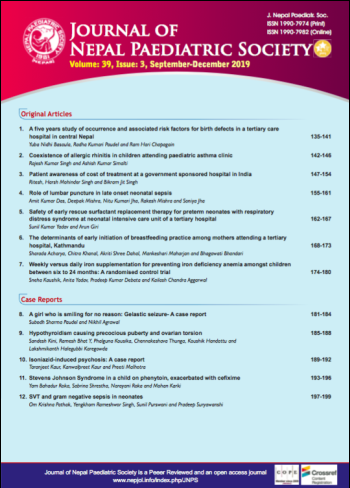Isoniazid Induced Psychosis: A Case Report
DOI:
https://doi.org/10.3126/jnps.v39i3.28503Keywords:
adverse effects, isoniazid, psychosis, tuberculosisAbstract
Psychosis is a state of altered behaviour and mentation and it is not common in children. Isoniazid is a commonly used drug in the treatment and prophylaxis of tuberculosis. It may cause psychosis if overdosed but rarely with usual recommended doses. We report a case of drug induced psychosis secondary to isoniazid intake in a seven years old boy, who exhibited psychotic features about 10 days after the commencement of anti-TB combination drugs (Directly Observed Treatment Shortcourse) containing Isoniazid. This patient had no past medical or family history of mental illness. Drug induced psychosis was a possibility, and the responsible drug (isoniazid) was stopped. He improved following the withdrawal of isoniazid. Isoniazid psychosis is a major complication as iatrogenic psychiatric complications can greatly impact the patients’ quality of life, which if recognised early can be effectively treated.
Downloads
Downloads
Published
How to Cite
Issue
Section
License
Authors who publish with this journal agree to the following terms:
Authors retain copyright and grant the journal right of first publication with the work simultaneously licensed under a Creative Commons Attribution License that allows others to share the work with an acknowledgement of the work's authorship and initial publication in this journal.
Authors are able to enter into separate, additional contractual arrangements for the non-exclusive distribution of the journal's published version of the work (e.g., post it to an institutional repository or publish it in a book), with an acknowledgement of its initial publication in this journal.
Authors are permitted and encouraged to post their work online (e.g., in institutional repositories or on their website) prior to and during the submission process, as it can lead to productive exchanges, as well as earlier and greater citation of published work (See The Effect of Open Access).



